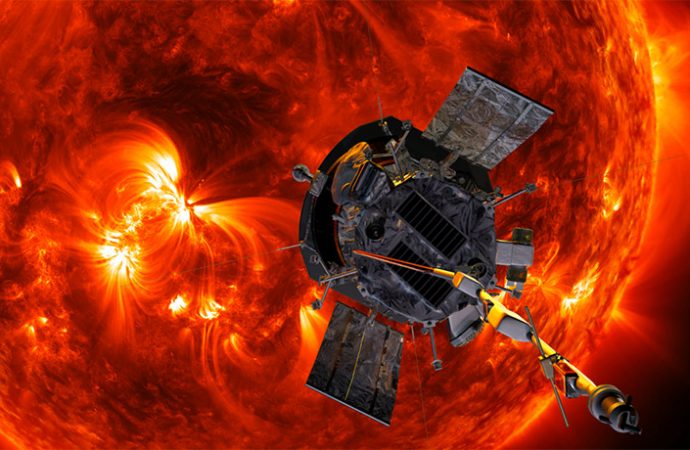We said hello to some spacecraft and good-bye to a few favorites
Several new space probes got their starts in 2018, while some sang swan songs.
Hello
1. TESS is on the lookout for planets
There’s a new planet hunter in town. The Transiting Exoplanet Survey Satellite, or TESS, launched April 18 to search the nearest, brightest stars in the sky for signs of orbiting planets.
TESS has already spotted at least two new worlds, one of which may be saturated with water.

TESS exoplanet-hunting telescope (illustrated) MIT
2. Parker Solar Probe aims for the sun
The Parker Solar Probe launched August 12 on an Icarus-esque journey to the sun. The craft made its first close flyby of our nearest star November 5 and began sending data back to Earth in December. Over the next seven years, Parker, built to withstand searing heat, will swoop ever closer to the sun, eventually coming to within about 6 million kilometers of the solar surface and directly sampling the sun’s wispy corona.

Parker Solar Probe JPL-Caltech/NASA
3. InSight touched down on Mars
NASA’s latest Mars lander, which reached its target November 26, will explore the whole planet while sitting perfectly still. With little more than a seismometer, a heat probe and time, InSight will listen for “Marsquakes” to figure out what Mars is like on the inside.

The InSight lander took this photo from the surface of Mars on November 26. Ed Whitman/JHUAPL, NASA
4. MASCOT and MINERVA-II hop to Ryugu
A trio of robots became the first to land on an asteroid. Japan’s twin MINERVA-II rovers and Germany’s MASCOT lander traveled to the asteroid Ryugu aboard Japan’s Hayabusa2 spacecraft. The MINERVA-II robots landed September 21 and hopped around, taking otherworldly pictures and measurements of the asteroid’s surface.
MASCOT landed October 3. Designed to live for only about 16 hours, MASCOT managed to show that Ryugu has almost no magnetic field, providing insight into the asteroid’s interior, mission scientists announced. Next year, Hayabusa2 will grab an asteroid sample, and return it to Earth in 2020.

MASCOT and the MINERVA-II twins explored asteroid Ryugu (illustrated). JAXA
Good-bye
5. End of the line for Kepler
The Kepler space telescope ran out of fuel just before November. The planet-hunting telescope was launched in 2009 to seek planets orbiting other stars. It succeeded spectacularly — discovering thousands of new worlds, some of which may have the right conditions for life, and showing that planets outnumber stars in the Milky Way.

Kepler exoplanet hunter (illustrated) NASA Ames Research Center, W. Stenzel, D. Rutter
6. Dusk for Dawn
Two days after Kepler’s demise, NASA announced that Dawn had sent its final message. The spacecraft was the first to orbit two alien places, first the asteroid Vesta and then the dwarf planet Ceres. The probe showed that the two worlds had remarkably different histories, even though they both live in the asteroid belt between Mars and Jupiter. Out of fuel, Dawn will silently orbit Ceres for decades, if not longer.

Dawn asteroid explorer (illustrated) JPL-Caltech/NASA
7. Missed Opportunity
The veteran Mars rover Opportunity fell victim to a dust storm this spring, and mission managers fear it has roved its last. The storm started May 30 and eventually covered the whole planet. The dust blocked so much of the sun that Opportunity’s solar panels couldn’t charge, and the rover put itself to sleep in June.
The dust cleared in August, but Opportunity has yet to phone home. The rover set records that will be hard to beat: After landing in 2004 for a mission that was supposed to last roughly 93 Earth days (90 Martian days), Opportunity roamed for more than 14 Earth years across more than 45 kilometers.

The Opportunity Mars rover took this selfie of its own dust-covered solar panels (middle) but is still silent after sitting out a months-long dust storm. JPL-Caltech/NASA, Cornell, Arizona State Univ.
8. Cassini keeps on giving
True, we said our tearful good-bye to Cassini in 2017. But this year, planetary scientists analyzed some of the last data that the spacecraft took of Saturn, including measurements of “ring rain,” a surprisingly complex cocktail of chemicals that falls from the planet’s rings onto its atmosphere. More analyses of Cassini’s data are sure to come.

Cassini (illustrated) plunged into Saturn last year, but the data the spacecraft collected continues to surprise.
Source: Science News

































Leave a Comment
You must be logged in to post a comment.